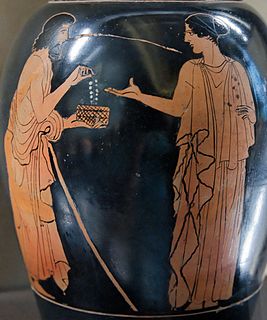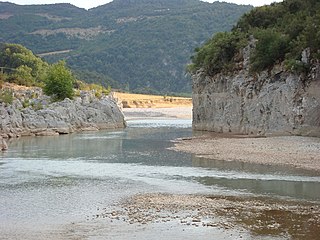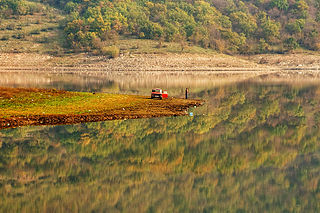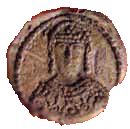This page is based on this
Wikipedia article Text is available under the
CC BY-SA 4.0 license; additional terms may apply.
Images, videos and audio are available under their respective licenses.

Year 917 (CMXVII) was a common year starting on Wednesday of the Julian calendar.

Acarnania is a region of west-central Greece that lies along the Ionian Sea, west of Aetolia, with the Achelous River for a boundary, and north of the gulf of Calydon, which is the entrance to the Gulf of Corinth. Today it forms the western part of the regional unit of Aetolia-Acarnania. The capital and principal city in ancient times was Stratos. The north side of Acarnania of the Corinthian Gulf was considered part of the region of Epirus.

In Greek mythology, Achelous was originally the god of all water and the rivers of the world were viewed by many as his sinews. Later, in Hellenistic times, he was mostly relegated to the Achelous River, which is the largest river of Greece, and thus the chief of all river deities, every river having its own river spirit.

Eriphyle was a figure in Greek mythology who, in exchange for a necklace given to her by Polynices, persuaded her husband Amphiaraus to undertake the raid which precipitated the Seven Against Thebes. She was then slain by her son Alcmaeon. In Jean Racine's 1674 retelling of Iphigenia at Aulis, she is an orphan whose real name turns out to be Iphigenia as well; despite her many misdeeds, she rescues Iphigenia the daughter of Agamemnon.

Aetolia is a mountainous region of Greece on the north coast of the Gulf of Corinth, forming the eastern part of the modern regional unit of Aetolia-Acarnania.

The Achelous, also Acheloos, is a river in western Greece. It is 220 km (137 mi) long. It formed the boundary between Acarnania and Aetolia of antiquity. It empties into the Ionian Sea. In ancient times its spirit was venerated as the river god Achelous.

USS Achelous (ARL-1) was one of 39 tank landing ships converted into landing craft repair ships for service in the United States Navy during World War II. The lead ship in her class, she was named for the Greek god Achelous, the only U.S. Naval vessel to bear the name.

Agrinio is the largest city of the Aetolia-Acarnania regional unit of Greece and its largest municipality, with 106,053 inhabitants. It is the economical center of Aetolia-Acarnania, although its capital is the town of Mesolonghi. The settlement dates back to ancient times. Ancient Agrinion was 3 kilometres northeast of the present city; some walls and foundations of which have been excavated. In medieval times and until 1836, the city was known as Vrachori (Βραχώρι).
The Battle of Anchialus refers to three battles between Bulgaria and the Byzantine Empire.
The battle of Katasyrtai (Kατασυρται) occurred in the fall of 917, shortly after the striking Bulgarian triumph at Achelous near the village of the same name close to the Byzantine capital Constantinople,. The result was a Bulgarian victory.
The Potamoi are the gods of rivers and streams of the earth in Greek mythology.

The Achelous-class repair ship was a class of ship built by the US Navy during World War II.

The Aheloy River or Achelous is a river in eastern Bulgaria. It originates in the Aytos-Karnobat mountain, 1.5 kilometres from Dryankovets, and flows directly into the Black Sea south of the village of Aheloy. The Aheloy River has a length of 39.9 kilometres and has an irrigation reservoir, the Aheloy Reservoir, built along its flow. The river's drainage basin covers 141 square kilometres and its average discharge is 0.7 cubic metres per second.

The Kremasta Dam is an earth-fill embankment dam on the Achelous River in Aetolia-Acarnania, Greece. It is located just downstream of where the Agrafiotis, Tavropos and Trikeriotis rivers meet to form the Achelous. The dam was constructed between 1961 and 1965 and its four 109.3 MW Francis turbine-generators were commissioned between 1966 and 1967. Shortly after the dam's reservoir, Lake Kremasta, was filled a 6.3-Mw earthquake occurred. This has been attributed to reservoir-induced seismicity. Lake Kremasta is the largest artificial lake in Greece.
Achelous and Hercules is a 1947 mural painting by Thomas Hart Benton. It depicts a bluejeans-wearing Heracles wrestling with the horns of a bull, a shape the protean river god Achelous was able to assume. The myth was one of the explanations offered by Greco-Roman mythology for the origin of the cornucopia, a symbol of agricultural abundance. Benton sets the scene during harvest time in the U.S. Midwest.
Achelous is a river god in Greek mythology.











